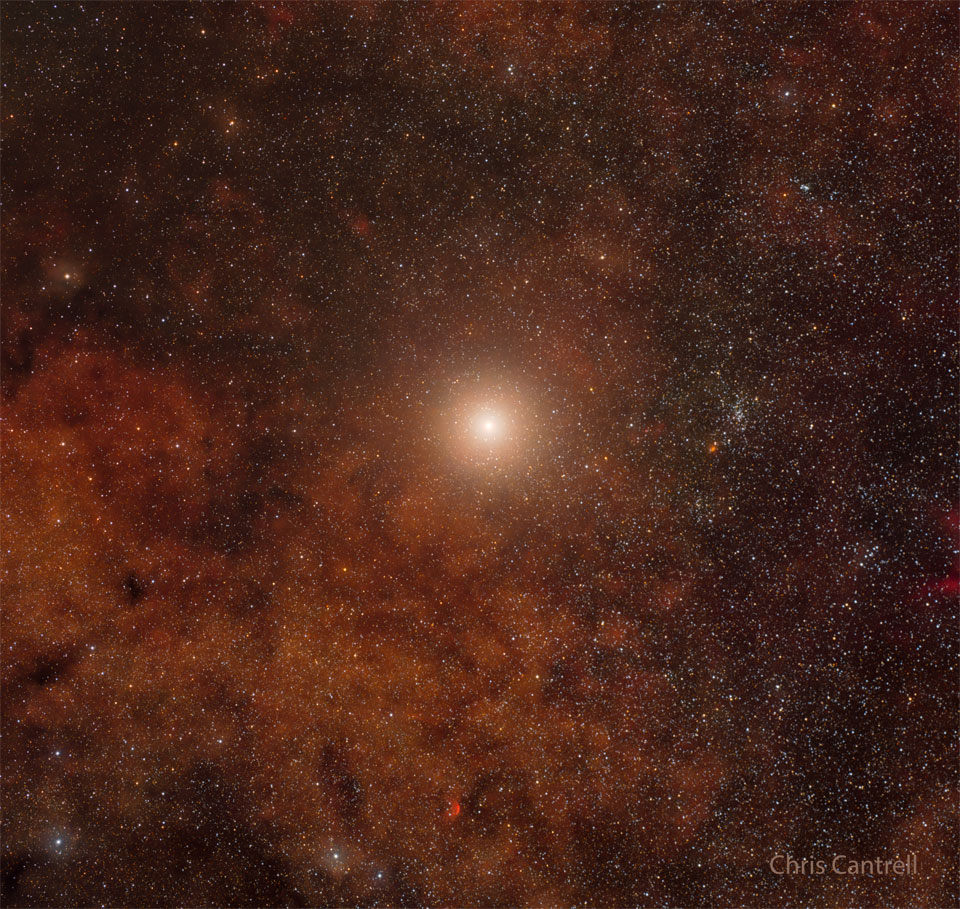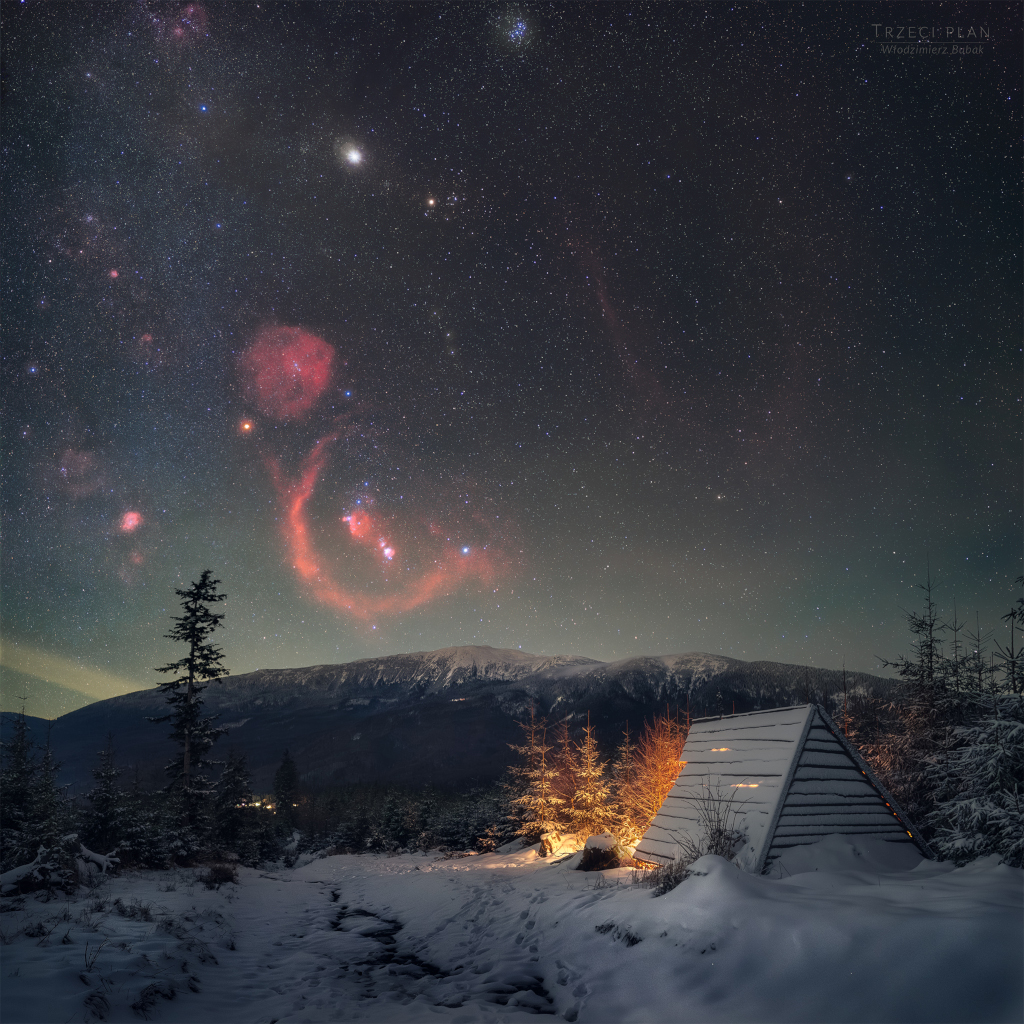Η Αστρονομική Εικόνα της Ημέρας από τη NASA
A Solstice Sun Tattoo
20/12/2025
The word solstice is from the Latin for Sun and to pause or stand still. And in the days surrounding a solstice the Sun's annual north-south drift in planet Earth's sky does slow down, pause, and then reverse direction. So near the solstice the daily path of the Sun through the sky really doesn't change much. In fact, near the December solstice, the Sun's consistent, low arc through northern hemisphere skies, along with low surface temperatures, has left a noticeable imprint on this path to the mountain town of Peaio in northern Italy. The morning frost on the road has melted away only where the sunlight was able to reach the ground. But it remains in the areas persistently shadowed by the fence, tattooing in frost an image of the fence on the asphalt surface.
Copyright: Marcella Pace
Προηγούμενες Αστρονομικές Εικόνες της Ημέρας από τη NASA
Welcome to Perihelion
04/01/2025
rth's orbit around the Sun is not a circle, it's an ellipse. The point along its elliptical orbit where our fair planet is closest to the Sun is called perihelion. This year perihelion is today, January 4, at 13:28 UTC, with the Earth about 147 million kilometers from the Sun. For comparison, at aphelion on last July 3 Earth was at its farthest distance from the Sun, some 152 million kilometers away. But distance from the Sun doesn't determine Earth's seasons. It's only by coincidence that the beginning of southern summer (northern winter) on the December solstice - when this H-alpha picture of the active Sun was taken - is within 14 days of Earth's perihelion date. And it's only by coincidence that Earth's perihelion date is within 11 days of the historic perihelion of NASA's Parker Solar Probe. Launched in 2018, the Parker Solar Probe flew within 6.2 million kilometers of the Sun's surface on 2024 December 24, breaking its own record for closest perihelion for a spacecraft from planet Earth.
Copyright: Barden Ridge Observatory
Eclipse Pair
03/01/2025
clipses tend to come in pairs. Twice a year, during an eclipse season that lasts about 34 days, Sun, Moon, and Earth can nearly align. Then the full and new phases of the Moon, separated by just over 14 days, create a lunar and a solar eclipse. But only rarely is the alignment at both new moon and full moon phases during a single eclipse season close enough to produce a pair with both total (or a total and an annular) lunar and solar eclipses. More often, partial eclipses are part of any eclipse season. In fact, the last eclipse season of 2024 produced this fortnight-separated eclipse pair: a partial lunar eclipse on 18 September and an annular solar eclipse on 2 October. The time-lapse composite images were captured from Somerset, UK (left) and Rapa Nui planet Earth. The 2025 eclipse seasons will see a total lunar eclipse on 14 March paired with a partial solar eclipse on 29 March, and a total lunar eclipse on 8 September followed by a partial solar eclipse on 21 September.
Copyright: Josh Dury
Solar Analemma 2024
02/01/2025
Recorded during 2024, this year-spanning series of images reveals a pattern in the seasonal drift of the Sun's daily motion through planet Earth's sky. Known to some as an analemma, the figure-eight curve was captured in exposures taken only at 1pm local time on clear days from Kayseri, Turkiye. Of course the Sun's position on the 2024 solstice dates was at the top and bottom of the curve. They correspond to the astronomical beginning of summer and winter in the north. The points along the curve half-way between the solstices, but not the figure-eight curve crossing point, mark the 2024 equinoxes and the start of spring and fall. Regional peaks and dormant volcano Mount Erciyes lie along the southern horizon in the 2024 timelapse skyscape.
Copyright: Betul Turksoy
Alpha Centauri: The Closest Star System
01/01/2025
The closest star system to the Sun is the Alpha Centauri system. Of the three stars in the system, the dimmest -- called Proxima Centauri -- is actually the nearest star. The bright stars Alpha Centauri A and B form a close binary as they are separated by only 23 times the Earth- Sun distance - slightly greater than the distance between Uranus and the Sun. The Alphasystem is not visible in much of the northern hemisphere. Alpha Centauri A, also known as Rigil Kentaurus, is the brightest star in the constellation of Centaurus and is the fourth brightest star in the night sky. Sirius is the brightest even though it is more than twice as far away. By an exciting coincidence, Alpha Centauri A is the same type of star as our Sun, and Proxima Centauri is now known to have a potentially habitable exoplanet.
Copyright: Telescope Live, Heaven's Mirror Observatory; Processing: Chris Cantrell
The Twisted Disk of NGC 4753
31/12/2024
What do you think this is? Here’s a clue: it's bigger than a bread box. Much bigger. The answer is that pictured NGC 4753 is a twisted disk galaxy, where unusual dark dust filaments provide clues about its history. No one is sure what happened, but a leading model holds that a relatively normal disk galaxy gravitationally ripped apart a dusty satellite galaxy while its precession distorted the plane of the accreted debris as it rotated. The cosmic collision is hypothesized to have started about a billion years ago. NGC 4753 is seen from the side, and possibly would look like a normal spiral galaxy from the top. The bright orange halo is composed of many older stars that might trace dark matter. The featured Hubble image was recently reprocessed to highlight ultraviolet and red-light emissions. APOD Year in Review: NASA Night Sky Network Presentation for 2024
Copyright: NASA
M27: The Dumbbell Nebula
30/12/2024
Is this what will become of our Sun? Quite possibly. The first hint of our Sun's future was discovered inadvertently in 1764. At that time, Charles Messier was compiling a list of diffuse objects not to be confused with comets. The 27th object on Messier's list, now known as M27 or the Dumbbell Nebula, is a planetary nebula, one of the brightest planetary nebulas on the sky and visible with binoculars toward the constellation of the Fox (Vulpecula). It takes light about 1000 years to reach us from M27, featured here in colors emitted by sulfur (red), hydrogen (green) and oxygen (blue). We now know that in about 6 billion years, our Sun will shed its outer gases into a planetary nebula like M27, while its remaining center will become an X-ray hot white dwarf star. Understanding the physics and significance of M27 was well beyond 18th century science, though. Even today, many things remain mysterious about planetary nebulas, including how their intricate shapes are created. APOD Year in Review: Night Sky Network Presentation for 2024
Copyright: Christopher Stobie
Methane Bubbles Frozen in Lake Baikal
29/12/2024
What are these bubbles frozen into Lake Baikal? Methane. Lake Baikal, a UNESCO World Heritage Site in Russia, is the world's largest (by volume), oldest, and deepest lake, containing over 20% of the world's fresh water. The lake is also a vast storehouse of methane, a greenhouse gas that, if released, could potentially increase the amount of infrared light absorbed by Earth's atmosphere, and so increase the average temperature of the entire planet. Fortunately, the amount of methane currently bubbling out is not climatologically important. It is not clear what would happen, though, were temperatures to significantly increase in the region, or if the water level in Lake Baikal were to drop. Pictured, bubbles of rising methane froze during winter into the exceptionally clear ice covering the lake. Jigsaw Challenge: Astronomy Puzzle of the Day
Copyright: Kristina Makeeva
A December Winter Night
28/12/2024
Orion seems to come up sideways, climbing over a distant mountain range in this deep skyscape. The wintry scene was captured from southern Poland on the northern hemisphere's long solstice night. Otherwise unseen nebulae hang in the sky, revealed by the camera modified to record red hydrogen-alpha light. The nebulae lie near the edge of the Orion molecular cloud and join the Hunter's familiar belt stars and bright giants Betelgeuse and Rigel. Eye of Taurus the Bull, yellowish Aldebaran anchors the V-shaped Hyades star cluster near top center. Still, near opposition in planet Earth's sky, the Solar System's ruling gas giant Jupiter is the brightest celestial beacon above this horizon's snowy peaks.
Copyright: Włodzimierz Bubak
Η Αστρονομική Εικόνα της Ημέρας από τη NASA (NASA Astronomy Picture of the Day) είναι μια δωρεάν υπηρεσία που παρέχει καθημερινά μια εντυπωσιακή εικόνα από το σύμπαν, την λήψη της οποίας έχει πραγματοποιήσει κάποιος από τους αστρονόμους της NASA ή από κάποιον από τους δορυφόρους ή τα τηλεσκόπια που η NASA λειτουργεί. Οι εικόνες που εμφανίζονται καλύπτουν μια ευρεία γκάμα από θέματα, συμπεριλαμβανομένων των αστερισμών, των γαλαξιών, των πλανητικών συστημάτων, των κομητών, των αστρικών σωμάτων και των παρατηρητηρίων. Κάθε εικόνα συνοδεύεται από μια σύντομη εξήγηση και πληροφορίες σχετικά με το τι παρατηρείται στην εικόνα.








